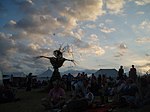Ault Hucknall
AC with 0 elementsBolsover DistrictDerbyshire geography stubsVillages in Derbyshire

Ault Hucknall (Old English: Hucca's nook of land) is a village and civil parish in the Bolsover district of Derbyshire, England. The population of the civil parish as of the 2011 census was 1,053.Local residents describe the settlement as the 'smallest village in England', as it consists of only a church and three houses. The philosopher Thomas Hobbes was interred within Ault Hucknall's St John the Baptist Church following his death in 1679.Hardwick Hall is within the parish boundary, which also contains the settlements of Astwith, Bramley Vale, Doe Lea, Hardstoft, Rowthorne and Stainsby.
Excerpt from the Wikipedia article Ault Hucknall (License: CC BY-SA 3.0, Authors, Images).Ault Hucknall
Ault Hucknall Lane,
Geographical coordinates (GPS) Address Nearby Places Show on map
Geographical coordinates (GPS)
| Latitude | Longitude |
|---|---|
| N 53.182 ° | E -1.302 ° |
Address
St John the Baptist
Ault Hucknall Lane
S44 5QH
England, United Kingdom
Open on Google Maps










